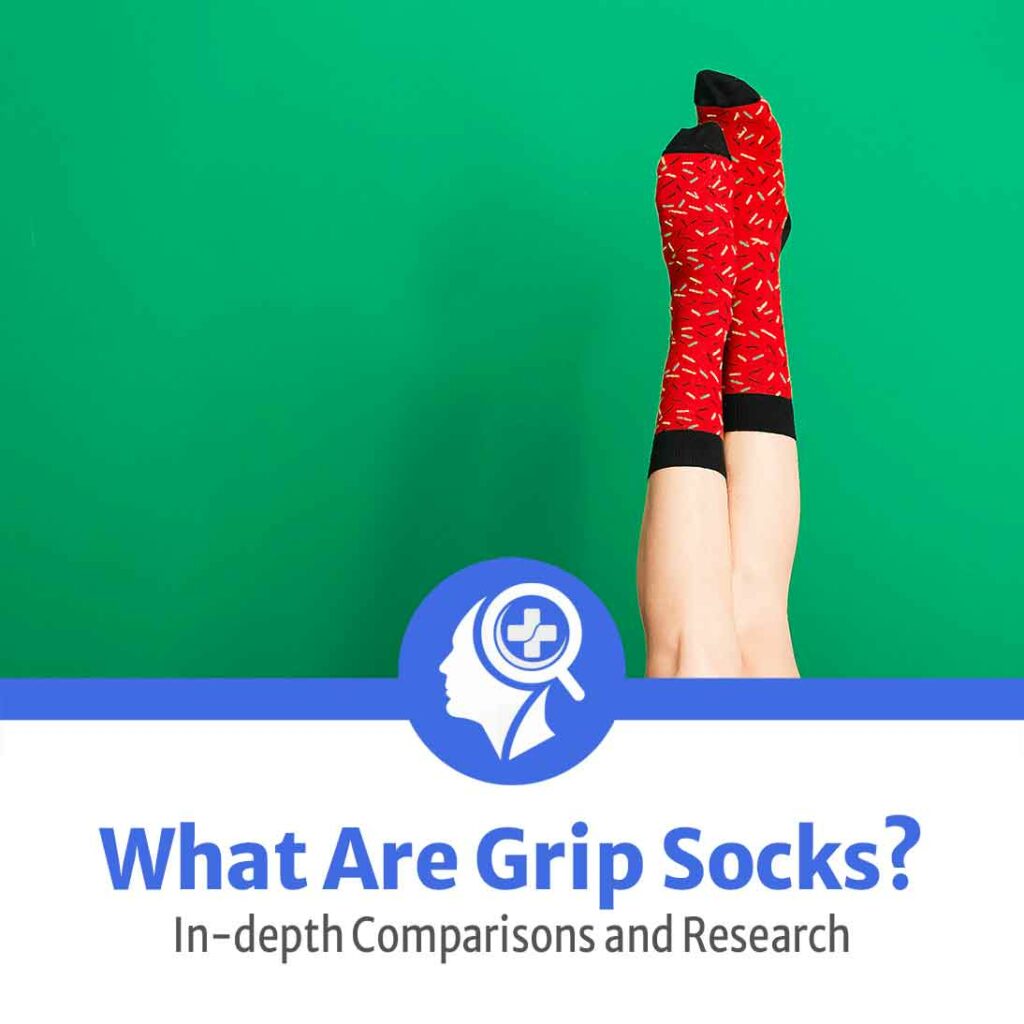
Grip socks, also known as non-slip socks, anti-slip socks, or gripper socks, are footwear designed to provide extra traction on slippery surfaces. These socks have rubber or similar material grips on the bottom, which helps prevent slips and falls.
They are commonly worn in yoga studios, dance classes, and other activities that take place on smooth floors.
This article will take a closer look at grip socks, including their benefits, how they are made, and when to wear them. Whether you’re a yoga enthusiast, a dancer, or just someone who wants extra stability on slippery floors, grip socks are a must-have for your shoe collection, as found by researchers at FinditHealth.

What Are Grip Socks Used For

Grip socks have non-slip grips or treads on the bottom, typically made of rubber or silicone. They are worn to prevent slips and falls on slippery surfaces, such as in yoga studios, dance classes, or other activities requiring traction on smooth floors. They are also known as non-slip, anti-slip, toe socks, or ankle socks.
Grip socks are used for a variety of activities that take place on slippery surfaces because of their grippy nature.
They are commonly worn in:
Yoga and Pilates
The non-slip grips on the bottom of the socks provide extra traction, which can help to improve balance and stability during yoga and Pilates postures.
Dance classes
Dance classes often take place on smooth floors, and grip socks can provide extra traction and stability for dancers.
Gymnastics
Gymnasts often practice on smooth surfaces, and grip socks can help to prevent slips and falls while performing tricks.
Physical Therapy & Hospitals
Patients in physical therapy may wear grip socks to help them balance and stability, especially during exercises on smooth surfaces. Patients in a hospital or elderly care facilities may wear grip socks to prevent slips and falls on smooth floors
Other activities:
Grip socks can also be worn during other activities such as martial arts, barre, and fitness classes on smooth floors. Some people even wear grip socks at home or work to prevent slips and falls on smooth surfaces.
By providing extra traction, grip socks can help to improve safety and performance during these activities. They can also provide extra cushioning and prevent blisters from forming.
Benefits Of Grip Socks

There are several benefits to wearing grip socks, including:
Improved safety
The non-slip grips on the bottom of the socks provide extra traction on slippery surfaces, which can help to prevent slips and falls.
This is especially important in yoga studios, dance classes, and other activities that take place on smooth floors.
They also improve balance and stability. This is particularly beneficial in activities such as yoga and Pilates, where balance and strength are essential. Grip socks can also provide additional support for patients in physical therapy or people recovering from injuries who need extra help with balance and stability.
Enhanced performance
The added traction and anti-slip grips can also help to improve performance in activities such as yoga or Pilates by allowing for better balance and stability.
Hygienic, Comfort, and Convenience
Grip socks are often required by gyms and yoga studios as a hygienic measure, as it prevents the spreading of foot fungus, warts, or other foot-borne illnesses. Grip socks are known to be extra comfortable as many are made from soft, breathable materials that keep feet comfortable, even during intense activities. Lastly, many grip socks can be machine-washed, making them easy to clean and maintain.
Variety
There are different types of grip socks available, such as full-toe, open-toe, or half-toe, that cater to the individual preferences and comfort of users. Some grip socks come in different colors and designs, making them stylish accessories.
However, it’s important to note that grip socks alone may not prevent all slips and falls and that proper technique and care should be taken when performing activities on slippery surfaces. They are additional aid to help with stability and balance but should not replace appropriate safety precautions and training.
Disadvantages Of Grip Socks

There are several disadvantages that are important to consider with grip socks. They do have reduced flexibility because the non-slip grips on the bottom of the socks can make it difficult to move and stretch your feet freely, which may affect your performance in activities such as yoga or Pilates.
Grip socks have limited use as they are designed for specific activities and are typically unsuitable for everyday wear or other activities.
Grip socks can also be more expensive than regular socks, which may be a disadvantage for some people. Some brands may have a narrow range of sizes and styles available, which reduces your options when purchasing grip socks.
Lastly, the rubber or similar material on the bottom of the socks can wear out over time, which may affect the effectiveness of the non-slip grip. This can also be influenced by sweating as some people may find that grip socks cause their feet to sweat more than regular socks, which can lead to discomfort and odor and the socks wear out.
It’s essential to consider your needs and preferences before purchasing grip socks right now and to be aware of their limitations and potential disadvantages.
What To Look For In Grip Socks
When looking for grip socks, here are a few things to consider:
- Material: Look for socks made from soft, breathable materials that will keep your feet comfortable during intense activities.
- Grip: The grip on the bottom of the socks should be made of rubber or similar material that provides good traction on slippery surfaces.
- Fit: Make sure to choose a pair of socks that fit well, as ill-fitting socks can be uncomfortable and may not provide the best traction. Grip socks also come in toeless styles that many people find more comfortable.
- Durability: Look for well-made and durable socks so they will last through multiple uses and washes.
- Hygiene: Look for socks that are easy to clean and maintain, to ensure they are hygienic.
- Design: Some people prefer open-toe or half-toe design, while others prefer the full-toe method. Choose the plan that you feel most comfortable with.
- Washing: Check if the socks are machine-washable or need to be hand-washed.
- Brand: Look for reputable brands with a good reputation for quality and customer service.
- Variety: Check if the brand offers different sizes, colors, and designs to choose from, so you can find the perfect pair of socks.
Considering these factors, you can find a pair of grip socks that will provide good traction, comfort, and durability for your specific needs.
Frequently Asked Questions

What are grip socks used for?
Grip socks have non-slip grips or treads on the bottom, typically made of rubber or a similar material. They are worn to prevent slips and falls on slippery surfaces, such as in yoga studios, dance classes, or other activities requiring traction on smooth floors.
How much of a difference do grip socks make?
Grip socks can make a significant difference in terms of safety and performance during activities that take place on slippery surfaces. The non-slip grips on the bottom of the socks provide extra traction, which has many benefits.
Can you wear grip socks with shoes?
Grip socks are typically worn without shoes, as they are designed to be worn directly on the skin to provide extra traction and stability on smooth floors. Wearing them with shoes may offer additional traction, as the non-slip grips on the bottom of the socks may not make contact with the surface. Additionally, wearing grip socks with shoes may cause discomfort and make it difficult to move your feet freely.
Do pros wear grip socks?
Whether or not professionals wear grip socks depends on the activity they are involved in and their comfort.
Conclusion – Research by Findithealth.com


In conclusion, grip socks, also known as non-slip socks, anti-slip socks, or gripper socks, are footwear designed to provide extra traction on slippery surfaces. They are commonly worn in yoga studios, dance classes, and other activities that take place on smooth floors. They have rubber or similar material grips on the bottom, which helps prevent slips and falls.
Grip socks can make a significant difference in terms of safety and performance during activities that take place on slippery surfaces. Professionals in yoga, Pilates, dance, gymnastics, physical therapy, and elderly care commonly wear them. However, our research team at FinditHealth thinks it’s important to note that grip socks alone may not prevent all slips and falls and that proper technique and care should be taken when performing activities on slippery surfaces.


